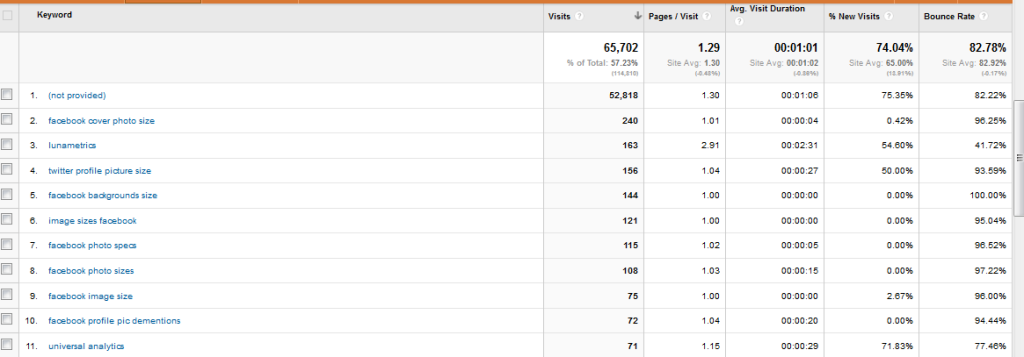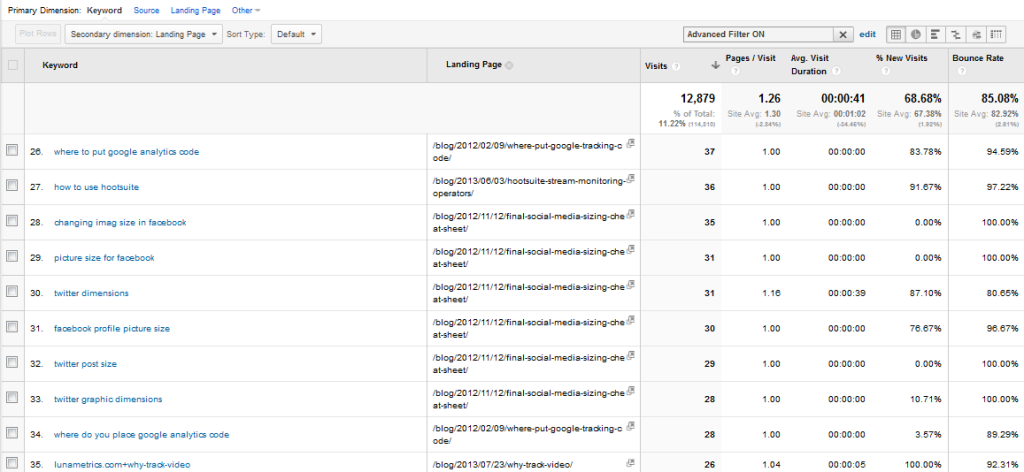SEO Measurement Mistakes Part 2: 10 Google Analytics Gaffes

This is Part 2 of a series titled SEO Measurement Mistakes. Links to the rest of the series below:
Part 1: 5 Huge SEO Measurement Mistakes
Part 3: Crawling and Indexation Metrics
Part 4: Links
In my last article, I discussed 5 ways people stifle SEO campaigns at the macro level by focusing on the wrong KPIs.
Today, I’d like to discuss a few common Google Analytics pitfalls we see when it comes to SEO.
1. Not auditing Analytics from the get-go
If I had a nickel for every website I’ve worked with that had Analytics configuration or data issues, I’d have about as many nickels as the number of websites I’ve worked on.
Whether it be PPC traffic counted as organic, inflated goal completions, un-tracked pages, mobile site data gone haywire, or what have you – there is a great chance your site’s GA profile has some bad or incomplete data on organic traffic.
The last thing you want is to be several months into the campaign and realize you’ve made important decisions based on crap data. Garbage in garbage out – so clean up that data straight out the gate.
When you launch a major marketing initiative – like hiring an in-house inbound specialist or kicking off an SEO campaign for a client – one of the first things you need to do is define goals and refine goal measurement.
2. Mishandling branded/non-branded segments



In the last article, we discussed the importance of organic non-branded traffic. Since onb such an important traffic segment, you want to get it right. Unfortunately there’s a lot of ways to get it wrong, including:
Neglecting secondary branded terms
Let’s say you’re Apple. The iPhone and iPad are two of your major brands. Thus, the non-branded traffic segment would exclude them. Your non-branded search segment is concerned with discovery of your website/brand, so any terms indicating previous familiarity with your brand need to be excluded, not just the name of your company.
Misspellings
I’ve got a client who must not have thought out their name that well because people always spell it wrong. Since their branded traffic converts at several times the rate of non-branded, I accidentally inflated revenue from organic non-branded traffic until I got real careful about excluding the many ways people misspell their name.
Neglecting branded terms
Sometimes SEOs don’t pay attention to branded traffic when they should. One reason branded traffic might be an SEO concern is if other sites are compete against you discussing or selling your brands – for example, “iPhone”. For circumstances like this, I utilize both “core brand” and “sub-brand” segmentation in GA.
3. Not segmenting beyond brand
If a large segment of visits has a 0.1% conversion rate, it shouldn’t be lumped in together with a segment of visits that has a 5% conversion rate right?
This is exactly what happens when, say, a marketer for a site for a New York City plumber focuses on increasing all organic non-branded traffic from all locations, whether it be California, Arkansas, Borneo, Peru, or wherever.
When you have a local target audience, or have any other hard constraint on your target audience, you should primarily focused on that segment – traffic from near the New York City area in our case – otherwise, poor Joe the plumber is going to wonder why visits to his site has quadrupled but there hasn’t been a dent made in leads.
In addition to monitoring a targeted organic non-branded traffic segment that excludes any obviously un-targeted traffic, consider creating additional segments to match important traffic segments that might require unique action plans. This can include metro areas, blog traffic, certin keyword segments, and much more.
4. Not accounting for (not provided)

I know how you feel about that black hole of keyword data tagged (not provided) – its like drowning in a sea of uncertainty.
Maybe you’ve made the mistake of looking at trends in revenue from organic non-branded visits and you noticed an amazing increase and you ran and told your boss how awesome you were and then your boss slapped you and said “You forgot to account for branded traffic within the non-provided keywords you idiot!”
Don’t fret friend. After you get done calling HR, just read this and estimate onb goal completions. While you’re at it, estimate onb visits as well.
Also, make sure when looking at the historical performance of a keyword group to not forget that the increase in (no provided) is naturally deflating those counts.
5. Inadequate use of time-frames in historical benchmarking
Comparing recent performance in major segments against historical performance is helpful in understanding if things are progressing well or if anything has changed for the worse and needs remedied. However, if your data comparisons are only month-over-month or only year-over-year, there’s a good chance you can arise at faulty conclusions.
The problem with month-over-month comparisons is that they don’t account for seasonality, and most websites have natural fluctuations in traffic that correlate with the time of year.
The problem with year-over-year comparisons is that they aren’t actionable – they don’t show any recent changes in traffic that may indicate a problem or opportunity.
To address these shortcomings, I recommend examining at least 18 months worth of data for trend analysis of organic non-branded traffic and any other critical segments. I also advocate using a combination of month-over-month and year-over-year reports for analysis of landing pages, keywords, and major traffic segments.
6. Not looking at landing pages along with keyword data

Shown above is the default report of organic traffic in Google Analytics. People spend a lot of time on this report examining keywords, but they often ignore landing pages.
Knowing what the keywords drive traffic isn’t as powerful if you don’t know where that traffic goes. Often there are several pages that could feasibly rank for the same keyword, so its important to see the data and not just guess.
Pair up the landing page as a secondary dimension on this report from time to time and you’ll have a better understanding of individual landing page’s role in keyword targeting. That way, you won’t make mistakes involving tweaks to the wrong page based on faulty data. Chances are, you’ll want to exclude (not provided) here to get straight to the good stuff.

7. Not distinguishing visits from visitors

Sometimes, the number of visits from a keyword shown in GA is drastically different from the number of actual visits from the keyword.
A tell-tale sign of this is when you see an obscure keyword with way more visits than you would expect that has 0% new visits or close to it. GA has a little quirk that when someone visits your site through from a known source and then visits again directly (for example, via bookmark) GA will attribute the visit to the last known source before the direct visits.
Thus, you’ll occasionally see keywords pop-up showing a lot of more visits than unique visitors, and its the latter that really matters for SEO insights. I’ve made the mistake of reporting keyword visit data in the past without accounting for this issue, and a headache ensued.
The best way to ensure you don’t fall prey to inflated keyword visit counts is to utilize the unique visitors metric – I take advantage of custom reports to keep this (and other) metric handy.
8. Ignoring Sampling when looking at conversions
If you have a site with a lot of visitors, you’ll probably come across a little yellow box in the upper right hand corner of GA when you’re digging in beyond the special reports.

Don’t ignore it.
Sure, for data at the higher level, like sitewide non-branded organic visit counts, you’ll probably have a big enough sample size to have rock solid estimates. But when you dig more granularly into data with big swings and smaller population sizes, like revenue or conversions for individual keywords or landing pages, the sampling can be wildly misleading.
Be careful before rushing to any decisions based on sampled data. Also, my man Sayf has a few ways to work around GA data sampling that could work for you.
9. Not keeping an eye on all traffic sources
Analyzing non-SEO traffic in Google Analytics reveals a number of important insights for SEO. Below are some examples of things to look at.
Search engines besides Google
Bing and Yahoo (which is powered by Bing) account for a total of over 30% of searches performed in the U.S. Since Bing has some differences from Google, it makes sense for SEOs to keep track of traffic by search engine My big horror story I share here is about a website that did a redesign that led to a 90% drop in Bing traffic that went undetected for weeks.
Referral Traffic
One great reason for SEOs to keep an eye on referral is to note big spikes so they can help fan the flames if content is going somewhat viral to enhance the number of backlinks earned.
Additionally, understanding which referring sources add lot of value helps understand what types of links add additional value, providing insight on which sites to build relationships with and which niches to pursue.
PPC
PPC data can be a goldmine of insight on keyword and landing page quality during SEO keyword analysis.
The big picture
Good SEOs pay attention to things other than SEO. If the main SEO for a site isn’t keeping an eye on all traffic sources, including traffic-types beyond SEO, they risk missing some opportunities and issues.
10. Not taking shortcuts
That’s a lot of data to keep an eye on, ain’t it? Effective SEO practitioners know they can’t constantly manually pull reports on all this stuff. Below are a few resources on shortcuts that help keep us sane.
I learned everything I know from Measurement Master Mike. Watch him in action.


